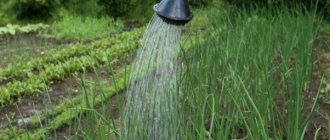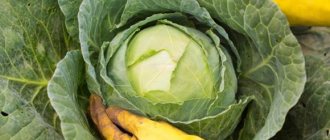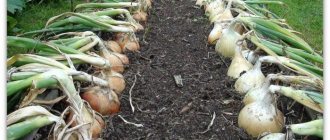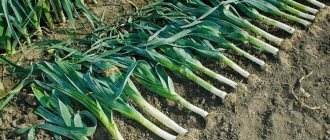Of the root crops grown in Russians' gardens and summer cottages, the radish is the first to ripen. But not all experienced gardeners know: a pleasant event, when a salad or okroshka with a vegetable grown by yourself appears on the table, can come as much as three weeks earlier. This chance is given by planting radishes in open ground before winter.
Your personal gardening consultant!
Early cucumbers and tomatoes are always welcome on our table.
But for all their advantages, even they cannot compete with radishes. There will be cucumbers and tomatoes, but no early pink radishes, and spring doesn’t seem to have come. In order for such a “holiday” to come on time, the seeds of the juicy pink vegetable must be planted before winter. In the spring it is also not prohibited, only then the harvest will have to be harvested 3-4 weeks later. In addition, winter planting is more profitable than spring planting. What are the benefits of winter planting?
If the conversation turns to benefits, then the question of whether radishes can be planted before winter is automatically removed. Of course, sowing radishes before winter is possible, but only if all recommendations are followed exactly. But first, let’s talk about whether it makes sense to do planting work in the fall in principle, and if so, what are their pros and cons.
1. Radishes are planted for the winter for the main reason - you want to have the vegetable on the table as early as possible.
2. “Winter” radishes get sick less, grow better, and are not afraid of spring frosts.
3. In winter, the seeds harden, undergo something like natural selection, when the weak ones die, the strong ones germinate and produce a good harvest.
4. With the beginning of spring, plantings receive the required amount of melt water, which makes it possible for seeds to germinate as quickly as possible.
There is only one disadvantage - sowing radishes before winter will end in failure if the timing is miscalculated. Planted seeds will be lost if planted too early. To prevent this from happening, it is better if the sowing is a little delayed than too early.
If the benefits of winter planting seem obvious to anyone, you need to decide which varieties of radish are most suitable for autumn. What are the recommendations? If any one or two varieties of seeds are available, they will not go anywhere, they will overwinter and produce some kind of harvest. When it is possible to choose one or the other, before winter it is better to plant the varieties “Zhara”, “Carmen”, “Zarya”, “Mayak”, “Yubileiny”, “Mercado”, “Pink-red with white tip”.
When to plant radishes before winter
The time of work is the main factor influencing the final result. After all, radishes before winter, when planting them now will be considered, are always a headache. It may not be strong, but to some extent it is true. It turns out that? Planting is usually carried out in October-December. It's kind of a vague rule. But the point is that sowing is carried out not so much on the “correct” days, but on the weather. Seeds can only be planted in cold, preferably slightly frozen, soil at the beginning of real winter. The warmth will return for at least a few days, the seeds will germinate and die. And the dates from October to December are determined taking into account both the local climate and the weather in a particular year.
How to properly prepare for landing
Any work, especially important work, begins with preparation. In the case of radishes, all preparatory measures are carried out in advance. What absolutely must be done.
Firstly. An area without shade and without drafts is selected. It is good if it is located on a small hill so that in the spring the melt water does not stagnate, and there is no more of it than planting requires.
Secondly. Dense soil is “diluted” with sand or peat. During the winter, the soil becomes compacted and seeds planted on black soil or clay will find it difficult to germinate in the spring.
Third. Fertilizers are applied. Organics or minerals, this is optional. For organic fertilizers, humus or compost (1-2 kilograms per 1 m²) are recommended. Mineral phosphorus-potassium can be anything. As an option - “Ammophos” according to the instructions. A glass of ash wouldn't hurt either.
Fourthly. In the prepared bed, grooves are made 4-5 centimeters deep. For the convenience of further work in the garden, the distance between the grooves should be at least 10 centimeters.
Fifthly. So that seeds planted in frozen ground have something to sprinkle, at the same time prepared soil is prepared and stored in a warm room. If someone doesn’t want to worry about storage, the land can be bought at the store.
At sixth. To avoid erosion of the beds by rain before planting, the equipped garden is covered with film.
In terms of timing, it is recommended that work preceding planting be carried out when it is still warm outside. And it doesn’t matter at all when the radishes will have to be planted before winter, and the beds should be ready no later than mid-October.
How to properly plant radishes before winter
Regarding the planting process itself, everything is good and simple with radishes. With the arrival of frost, seeds are sown in the furrows. Sprinkle with 1.5-2 centimeters of warm earth (prepared or from the store). A layer of mulch (4-5 centimeters) is placed on top of the beds. In addition to mulch, it would be a good idea to insulate the garden with a 20-centimeter layer of foliage. And lastly, when sowing in autumn, you need to take one and a half times more seeds. Over the winter, a certain number of them will certainly die.
Despite the fact that planting radishes before winter is somewhat risky, such an undertaking is quite feasible. And the risk, in fact, no longer lies in the sowing itself, everything is elementary here, but in the preparation for it and choosing the right time for the work. So, stories about the impossibility of pre-winter planting are more fiction than truth.
Share useful information:
Pre-winter sowing - early vitamins from the garden
By spring, we had already used up the supply of vitamins accumulated over the spring, summer and autumn, when there was an abundance of fresh berries, vegetables and fruits. Fruits and vegetables stored for winter, no matter what ideal conditions are created for them, lose a significant part of their nutrients by spring. How can we make up for the resulting deficit?
You can buy gifts of nature in a supermarket or market. Of course, if you trust the integrity of the manufacturers. Or purchase a complex of vitamins in tablets at the pharmacy (and don’t forget about quality here). But there is another way: to sow vegetables and herbs in your garden before winter.
In early spring, the lack of vitamins is especially acute.
Leaf and head lettuces, arugula, dill, parsley, spinach, spring onions, radishes, beets and carrots - how do you like the star composition for a spring vitamin salad? Do you remember that young leaves and petioles of carrots and beets are a storehouse of vitamins? They are also in the salad! Before winter, you can also sow cauliflower, Chinese and red cabbage, salad mustard, celery (for greens), borage and parsnips.
Choose varieties of greens and herbs for sowing before winter in our catalog, which contains offers from large online stores of seeds and planting material. Choose seeds of greens and herbs.
Winter sowing of radishes
Gardeners who prefer to sow radishes before winter note that such an event has many advantages. Thus, these include the possibility of early harvest (about 20–25 days faster than with conventional sowing), seed hardening, due to which young shoots better tolerate spring frosts, as well as their saturation with water, which allows you to obtain juicier and crispier root vegetables . Another advantage is that there is no need to control pests on emerging shoots, since they are inactive in early spring. But winter sowing also has its disadvantages. For example, you will have to be more careful when choosing a variety - before winter, it is recommended to sow only early-ripening, cold-resistant varieties that are resistant to lack of light and flowering. There is also a high risk of seedlings falling out, and not all seeds will be able to germinate, so store about a third more than you want to sow (some gardeners advise increasing this amount by half). And taking into account the fact that radishes are sown quite late, your stay in the garden plot may last until late autumn.
Is it worth the risk?
This issue must be resolved by each gardener personally. But it is worth paying attention to several clear advantages of sowing vegetables in winter. Let's voice them:
- it will allow you to get a harvest 2-3 weeks earlier than in spring, and if you cover the seedlings with film (or other covering material), you can speed up ripening by another 7-12 days. The result is almost a month!;
- seeds that spent the whole winter in the ground were well hardened, went through natural selection (the weak ones died), which means the plants will be stronger and healthier;
- with winter sowing, you can forget about worries about a dry spring: as soon as the snow begins to melt, the seeds swell and begin to grow together, using 100% of the spring moisture, at a time when spring sowing is still being planned.
The seeds have hardened well over the winter, which means the plants will be stronger and healthier
- resistance to frost, diseases and pests: young sprouts of winter-sown vegetables and herbs can withstand short-term negative temperatures without loss (from personal experience I can say that a temperature of -3°C will not cause them the slightest harm), and early shoots are not attacked by carrot flies and cruciferous flea beetles, which are still sleeping at this time.
Read also: What palm trees grow in Crimea
When and what radishes are planted in the fall in a greenhouse and open ground
It is necessary to plant radishes in open ground in early September (late August). In greenhouses, planting is carried out no later than September 20. With such sowing dates, root crops will ripen in the fall. The best predecessors of radishes on ridges will be:
Radishes can be planted on the ridge after the pepper growing on it
Do not plant radishes after radishes, daikon, cabbage, and other cruciferous vegetables. It shares the same diseases with these cultures.
Radishes should not be grown in one place for more than 3 years, otherwise it will lead to soil depletion.
The last wave of autumn planting of radishes can be done in late autumn, after November 15, during the period of persistent cold weather (before winter). The harvest from this planting will be ready in the spring, but it will ripen 2-3 weeks earlier than with spring sowing of any variety of radish.
For autumn plantings, early ripening varieties with elongated root crops are predominantly chosen:
- 18 days. The root vegetable is not very large, pink in color, with a white tip.
- French breakfast. Resistant to color fade.
- Duet. The fruits are pink with a white tip.
Photo gallery: early ripening varieties of radish
The ripening period of these varieties is from 18 to 25 days. Such root vegetables are not stored, but eaten. The Red Giant and Autumn Giant varieties are suitable for storage.
Red giant is a late variety that has cylindrical large pink roots weighing about 120 grams. The time interval between the emergence of radish shoots and harvesting is estimated at 50 days. Root vegetables can be stored for up to 4 months at temperatures around zero.
The Red Giant variety is planted in a greenhouse to obtain a harvest for storage.
The autumn giant is also stored for a long time (up to 2 months). Its growing season is one month. The rounded, flattened fruits have a white skin.
The Autumn Giant harvest ripens within a month
So that these varieties have time to fully ripen, it will be more reliable to plant them in a greenhouse in the fall.
Video: correct agricultural technology for autumn radishes in a greenhouse
For the last plantings, before winter, it is worth choosing the varieties Zarya (18‒25 days) and Zhara (15‒18 days) . The main criterion for their selection is resistance to the formation of arrowheads, frost, and lack of light.
Heat radishes are chosen for sowing in late autumn
These varieties are also suitable for sowing for autumn consumption.
Video: Zhara and Zarya varieties - September harvest
Winter varieties of radish. The best varieties of radish for open ground
Radish, or radish in common parlance, belongs to the Brassica family, the genus Radish. This is a vegetable whose root crop is consumed mainly fresh. The product is low in calories, contains isothiocyanates and serves as a source of the first vitamins in spring. Radish root (from the Latin Radix) can have various shapes (cylindrical, spherical, cone-shaped, etc.) and colors from white to deep burgundy (purple). Breeders have developed many varieties for indoor and open ground with different characteristics.
Seed selection
Properly selected radish seeds are the key to a good harvest. When purchasing, you should give preference to seed material no older than 2-3 years. Seeds should be:
- Clean. Free from foreign matter of weeds and debris.
- Ripened. Ripe seeds are brown.
- Calibrated. One size.
- Elastic. Dense structure with a waxy sheen.
- No signs of bacterial damage (mold, rot, deformities).
On sale there are regular and pelleted or encrusted seeds in a special shell of growth stimulants. The first ones require pre-planting preparation (soaking, pickling), the second ones do not.
The shell not only contains a supply of nutrients, but also protects the seeds from germination and disease.
You should pay attention to the labeling of the packages:
- In which regions is the variety zoned?
- Radishes are recommended for cultivation in open or closed ground.
On a note! Most varieties for open ground are grown safely in greenhouses and greenhouses.
Radish varieties for open ground
In the climatic conditions of central Russia, sowing radishes in open ground is carried out in April. For example, in the Moscow region, it is recommended to cover such plantings with covering material due to the likelihood of a sharp drop in temperature. In the south, sowing is carried out in early to mid-March.
It should be remembered that radishes are a plant of short 12-13 hour daylight hours. Lack or excess of light leads to the growth of tops, bolting and cessation of growth of the edible part of the root crop.
Note! You should not plant radishes after other cruciferous crops: cabbage, radishes, turnips, mustard.
The best varieties of radish for open ground:
- French Breakfast is an early ripening variety of domestic selection. Recommended for cultivation in all regions of the Russian Federation. From the appearance of the first shoots to harvest - about 3-3.5 weeks. Root vegetables, weighing 15-18 grams, elongated-cylindrical in shape. The skin of the radish is raspberry-pink, the tip is white. The variety is resistant to bolting and temperature changes. The taste is excellent.
- 18 days – ultra-early variety, bred in the Russian Federation. Harvesting - 2.5-3 weeks after the first shoots. It is cultivated everywhere in open and closed ground. The elongated, blunt-pointed roots are soft pink at the surface with a white tip. Radish weight – 18-20 grams, circumference – up to 2 cm. Resistant to flowering, common diseases, can withstand frosts down to -2°C. If there is a lack of moisture, it may become bitter.
- Zhara – the variety was registered in 1956. From germination to ripening of root crops - about 3 weeks. The shape of the radish is elongated-spherical, the color is red. The variety is especially popular in the North-West of Russia, in the Leningrad and neighboring regions. Radishes of this variety are actively grown in Belarus and the Baltic republics.
- Early red – from entry to harvest 3-3.5 weeks. Radish Early Red is a time-tested early variety, bred in the USSR in 1978. It is distinguished by spherical red root vegetables, weighing up to 25-30 grams. Not picky about soils, resistant to bolting.
- Mercado is a mid-season variety, from the first shoots to ripening - about a month. Cold-resistant, resistant to blooming and cracking. Round pink root vegetables reach a weight of 20-30 grams. Radishes have juicy white flesh. The taste is excellent without any tart bitterness.
- Pink-red with a white tip is an early ripening (3-4 weeks) radish variety of domestic selection (1940). The root crop is round-oval, up to 4-5 cm in length and 3.5-4 cm in diameter. The color of the radish corresponds to the name, the flesh has a pink tint. The taste is sweetish, the pungency is faintly noticeable. The variety is prone to bolting.
- Red Giant (radicula 'krasniy velikan) - registered in the State Register of Breeding Achievements in 1958. Red giant radish, or Red Giant radish, is a large variety with a medium or medium-late ripening period, 1-1.5 months before harvest. The weight of large reddish root crops can reach up to 80-100 (300) grams, length - up to 15-18 cm. The yield is high - 3-4 kg per 1 m² of planting. It is recommended to sow this radish in open ground in the Volga region, the Far East, and the Central and North Caucasus regions.
- Rubin is an early ripening variety, bred in Ukraine, registered in 1947. It is zoned throughout the Russian Federation, but is most successfully grown in open ground in the south of Russia: Volgograd, Rostov, Saratov regions. The root vegetables are round, red, and reach technical ripeness (weight up to 20-25 grams) in 3-3.5 weeks.
Instructions for sowing
When planting radishes in September, fertilizers are applied to ridges freed from plant residues per 1 m2 of land:
- 2‒3 kg of humus,
- 1 tbsp. l. potassium sulfate and superphosphate (these fertilizers can be replaced with a glass of wood ash),
- 1 tsp. urea.
The soil with fertilizers is dug up or well loosened.
In autumn, radish seeds are placed in the ground less often when planting than in spring . It is necessary to ensure that the plants have enough space to grow and that they have good sunlight during the short daylight hours.
The norm (standard) for autumn sowing of radish seeds is 1g/1m2 (approximately 125 pieces).
Landing is carried out as follows:
- Furrows are made in the garden bed 15-20 cm apart.
- Water them with water, from a dispenser.
- The seeds are scattered into the furrows, maintaining a distance between seeds of 5–7 cm. The seed planting depth is 1.5–2 cm.
- The top is covered with earth.
Features of care
To get a good harvest in the fall, radishes must be properly cared for:
- 4–5 days after germination, when two true leaves appear on the sprouts, excess sprouts are removed and 8–10 cm are left between plants.
- Every 4-5 days the ridge is weeded to remove weeds.
- To maintain moderate humidity, the bed is watered twice a week. If the weather is hot, the plantings are irrigated every 2 days.
- During the growth period, when the size of the root crop reaches the size of a match head (cherry pit), the radishes are fed by scattering ammonium nitrate over the bed (1 tbsp./10 m2), and the bed is well watered.
- To prevent the soil from becoming crusty, it is loosened after watering or rain.
Reviews from gardeners
I really liked the Zhara variety, very early, 18 days. I planted it at the end of August, when we already had continuous rains and cold, the tops were small, and the root crop grew very decently and really quickly, next season I will only plant it.
charodey
https://www.forumhouse.ru/threads/298380/
I tried to plant radishes in the middle of summer - they grew into shoots. It turns out that he needs a certain daylight hours! I sowed it in August and forgot about it, but in September I came across it and gasped! Huge, beautiful, delicious!
Natasha
https://dv0r.ru/forum/index.php?topic=128.msg4614
We love radishes. It also turns out good when sown in autumn, especially Cherriet and Riesenbutter. They grow as in the picture, and Riesenbutter is large, it does not come with voids.
Lidia Provotorova
https://otvet.mail.ru/question/204559032
My fall sowing is just great.
Anatoly Yakovlev
https://otvet.mail.ru/question/204559032
Radishes planted in the fall give a good harvest if you choose the right varieties for sowing, adhere to planting dates, and properly care for the plants.
The benefits of growing radishes before winter
Winter sowing of radishes has many advantages, which is why gardeners plant them, despite a certain risk of crop loss. The main advantages of growing radishes before winter include:
- Possibility of harvesting in May . Root crops ripen 2-3 weeks earlier than those planted in spring. If you cover the bed with film, you can reduce this period by another 7-10 days.
- The harvest is of high quality . All diseased and weak seeds in frozen soil die. Only the strongest buds remain, from which healthy radishes grow.
- In early spring, the seeds do not require watering . To germinate, they only need the moisture they receive from the soil when the snow melts.
- The plants are resistant to pests , since their main enemies, the carrot fly and the cruciferous flea beetle, are still sleeping.
- Frost resistance of the crop . Crops that have survived the winter are not afraid of spring frosts.
If the seed turns out to be of poor quality and does not sprout, the gardener will not be left without a harvest. He always has the opportunity to sow new beds in the spring.
What are the benefits and risks of planting radishes for the winter?
Is it worth planting radishes before winter, how expedient and practical is this? On the one hand, the risk that the seedlings will die is quite high, especially if you choose the wrong time for sowing. On the other hand, winter sowing of radishes has many advantages:
Read also: Buns in a frying pan recipe with photos
Planting radishes before winter also contributes to plant resistance to diseases, frosts and pests.
- The winter radish harvest will be ready for harvest 2-3 weeks earlier than with spring plantings. If the seedlings are also covered with film, ripening will be accelerated by a week;
- When planted in late autumn, radish seeds spend the entire winter in the ground, they are hardened and undergo natural selection, in which only the strongest survive. As a result, vegetables grow healthy and strong;
- When planting before winter, you do not need to worry about a lack of moisture in the spring, since melting snow fully provides the seeds with moisture, they swell and germinate. When planting in spring, additional watering may be required if the spring is dry;
- Planting radishes before winter also contributes to plant resistance to diseases, frosts and pests. Young radish sprouts that appear after dormancy throughout the winter tolerate frost well; the seedlings do not suffer from pests, since the cruciferous flea beetle is still dormant at this time.
However, it is worth noting that plants will have the listed benefits only if they survive the winter well. For this to happen, it is necessary to sow on time.
Autumn varieties of radish for planting before winter
When choosing a radish variety to plant before winter, you need to focus on three main criteria:
- resistance to shooting;
- good frost tolerance;
- low need for sunlight.
The best radish varieties that are suitable for planting in the fall are listed in the table below:
Radish Pink-red with white tip
The listed radish varieties are used for planting before winter, as they best tolerate frost.
Choosing varieties for winter sowing
How to plant radishes is already known, all that remains is to decide on the plant varieties for winter planting. The main criteria for choosing varieties should be resistance to bolting, frost, and lack of light. Experienced summer residents recommend using the varieties “Zhara”, “Zarya” and pink-red with a white tip for winter planting. “Heat” and “Zarya” are early ripening, the first ripens in 15-18 days after germination, the second in 18-25 days. “Zarya” is also valued for its high yield and slightly spicy but mild taste. In addition to good yield, it boasts resistance to low light, which is very important for winter plantings.
The pink-red radish variety with a white tip is a mid-early variety, it ripens 25-30 days after germination. The main advantage of this variety is its pleasant taste, which is very popular among summer residents.
Planting radishes before winter is a risky undertaking, but if you do everything correctly, then at the beginning of spring you will have fresh, vitamin-rich vegetables on your table that will undoubtedly bring a lot of benefits to your health!
Conditions for growing radishes before winter
In order to get the long-awaited radish harvest in the spring, you need to properly plant the seeds in late autumn. To do this, 5 conditions must be met:
- The bed should be on a hill . This will prevent the seeds from flooding when the snow melts.
- The predecessors of winter radish seeds can be cucumbers, tomatoes, legumes, and potatoes . You should not plant root vegetables in the area where you previously grew: horseradish, watercress, cabbage or radish. Radishes do not grow well in beds that have been populated with cruciferous vegetables. It should not be planted in the same place for 3 years in a row, even if fertilizer is applied.
- For planting before winter, you need to take 2 times more seeds than in the spring . This will reduce the likelihood of crop loss due to death or poor quality of crops.
- Be sure to calibrate the seeds before adding them to the soil. To do this, they are immersed in salt water for several minutes. Only the material that has sunk to the bottom is planted. The floating seeds are thrown away.
- After drying, the seeds are disinfected . A weak solution of potassium permanganate is suitable for this purpose. The holding time for future radishes should not exceed half an hour. After removing the seeds, they need to be dried. This will allow them to gain moisture and swell, but not germinate.
By adopting these recommendations, you can minimize the risk of seed death and get a high yield of radishes.
Landing dates
The timing of planting radishes before winter depends on the region of Russia, since the climate in different parts of the country differs significantly. It is also important to consider the weather at the time the seeds are placed in the ground.
The optimal soil temperature is -1-0 degrees. The soil freezes slightly under these conditions. An indispensable condition is the onset of stable frosts. Otherwise, the seeds will germinate during the thaw and freeze when cold weather arrives.
In the Moscow region, winter radishes are planted in the second half of October. In the northern regions of Russia, seeds are sown earlier - in early October. Residents of the southern regions can afford to add seeds to the soil even in early November.
There is no exact date for planting radishes before winter. It is important to take into account the weather forecast for a particular year. The plant is planted when there is confidence that the air temperature will no longer rise above 0 degrees. The gardener's lunar calendar, developed for a specific area, can help determine the timing.
Beet varieties for sowing before winter
'Podzimnyaya A-474' Mid-early variety, ripens in 55-100 days after germination. It is valued for its cold resistance, resistance to cercospora and flowering (formation of flower stalks), high taste and shelf life.
' Cold-resistant 19 ' Mid-season variety, from germination to harvest it will take 65-75 days. High taste, resistant to cold, color, and stores well.
' Egyptian flat ' Mid-season variety, 95-120 days from germination to technical maturity. It is valued for its consistently high yield, excellent taste, and resistance to the formation of peduncles. Zoned everywhere.
' Polar flat K-249 ' The variety is zoned for the northern regions; root crops will form 50-90 days after germination. Valued for its high resistance to cold, flowering, and pests (root beetles).
And beet seeds for winter sowings can be selected in our catalog, which contains offers from many large garden online stores. Select beet seeds:
Many summer residents, if they visit their lands in November-December, do so only to prepare their houses and outbuildings for winter, and rarely do anyone engage in sowing. However, planting radishes before winter with the onset of the first frosts is still quite possible.
Read also Why do you dream about giving birth to a piglet?
Soil preparation
The area should be well lit. Shaded places for planting radishes before winter are not suitable. The better the soil warms up, the faster the first shoots will appear. In addition, a lack of sunlight will cause the radishes to begin to grow tops, and the fruits themselves will be small.
If the soil is too dense, then you need to add peat or sand to it in advance. During the winter period, the soil always loses its former looseness, so it will be difficult for the seeds to break through to meet the sun.
If the soil is poor, it needs to be fed. Organic fertilizers in the form of humus or compost are suitable for this purpose. For 1 sq. m take 1 kg of fertilizer. Alternatively, you can use minerals containing phosphorus and potassium. They should be applied according to the instructions for use. Radishes love soil rich in ash, so you can add a glass of this fertilizer to the garden bed.
You need to take care in advance of the availability of warm soil, which is used to sprinkle the seeds. To do this, you need to keep it in a warm room for some time.
The beds are prepared before frost sets in. It will be difficult to make furrows and apply fertilizers in hard soil frozen by frost.
When fertilizers are applied to the future location for planting radishes, the soil is dug up and furrows are made in the bed. Their depth should be about 4 cm. The minimum width of the space between the furrows is 10 cm. If the garden space allows, you can increase this gap by another 5-10 cm. You need to make sure that there are no stones or lumps left in the garden bed. Only in loose soil will the seeds feel comfortable. If the soil is highly acidic, slaked lime must be used.
To prevent the prepared plot of land from being washed away by rain or blown away by winds, it is covered with film. Regardless of the planting time, you need to prepare the bed in the first half of October.
What can be planted in open ground before winter. Planting greenery before winter = super early harvest!
Greens are always relevant, especially with spring vitamin deficiency! (Photos in the article are taken from the Internet)
Greens are an integral part of our table. It is especially pleasant to use fresh herbs grown with your own hands. This harvest will be tasty and full of vitamins. And, as many people know, it is not necessary to start sowing in the spring, having received the first bunch of greenery in early summer. If you start working at the end of autumn, then the first fresh greenery will delight you already at the beginning of spring.
Advantages of planting greenery before winter:
- The greens that you plant in the fall will be stronger and healthier, because they have already been hardened during the winter.
- Infectious diseases are unlikely to harm your harvest.
- Early greenery will not be threatened by aphids, because the main activity of these insects will occur during the period when the crop is already formed.
- Another benefit will be that in the spring you will have more time to work on the rest of the garden.
- The harvest will be super early - soon after the snow melts (the exact timing depends on weather conditions in your region).
Not bad, isn't it? Now you see that sowing greenery before winter is not such a complicated process, moreover, in some ways it is easier (you don’t need to worry about pests and diseases, thanks to the melted snow you don’t have to worry about soil moisture).
What greens can be sown before winter:
Beautiful dill in the garden
- dill;
- spinach;
- mint;
- cilantro;
- sorrel;
- parsley;
- salad.
When and how to plant greens?
Basil is one of the most unpretentious crops!
There is no exact date in this case, since the weather is changeable. But there are some criteria by which you can determine when it is time to sow:
1. At a temperature of 0° it is already possible to start sowing, only under the condition that no warming is expected. Usually this is mid-October - November.
2. An important criterion is freezing soil. This is necessary to ensure that the seeds do not swell and germinate ahead of time!
How to prepare seeds?
Parsley and its seeds
For winter sowing, use dry seeds; you can try planting seeds placed in clay tablets (clay will serve as protection against rodents). Sow in beds, and cover the seeds with peat or compost on top. On top of a layer of warm soil (peat, compost), cover the seeds with a layer of mulch .The recommended number of seeds is standard, as in spring. You can sow a little more seeds, but be aware of moderation - with a large number they may be too crowded. There is no need to water the seeds - in the fall they can sprout from this, and in the spring the melted snow will be enough for them.
It is important to prepare the soil in advance and choose the right place for sowing before winter
green corner in the country house
Choose a flat bed in a sunny place, which will warm up faster and where the soil dries out faster. It is advisable that the bed be slightly raised - about 15 cm, if the sowing area is quite low.
An important point - do not choose a garden bed where a lot of snow accumulates in winter. Otherwise, it may drown the seeds when it melts.
Prepare the soil in advance. To do this, in September (you can also do it in October), you need to dig up the soil well, break up large pieces and add fertilizer (for example, peat or humus). Another point is baking powder. Cold-resistant crops love light, loose soil, so you can add sand to it along with fertilizer. After this, level the bed with a rake and create furrows about 1-10 cm deep. All these rules for sowing before winter are suitable for all the greens listed above.
Features of planting radishes in autumn
To prevent radish seeds from dying during winter frosts, you need to observe some features of planting them in the fall. Mandatory rules include:
- Seeds should not be planted in the soil to a depth of more than 5 cm. They must be dry.
- For better visibility, the seeds are pre-marked. They are kept for about 3 minutes in a 1% iodine solution. Then the seeds are sprinkled with chalk. This will allow them to be more evenly distributed throughout the bed.
- The distance between each seed should be about 3 cm.
- When planting is completed, the bed is sprinkled with pre-prepared soil.
- The top of the planting is covered with a layer of mulch. It will act as a cushion that protects the seeds from sudden changes in temperature, thaws and frosts that are characteristic of the spring period. A good material is spruce branches (spruce, pine) or dry branches of shrubs. The mulch layer should be at least 20 cm.
- In winter, you need to come to the garden plot to additionally cover the bed with snow. This will increase the chances of successful seed survival.
Watering the beds after planting is not allowed. Otherwise, the seeds will begin to germinate and die with the onset of real frost.
Cultivation care
In winter, radishes do not require any care. After the onset of heat, the bed is cleared of the layer of mulch and the first shoots are waited for. The covering material can be removed only after warm weather has settled.
After the first shoots appear, the bed needs to be thinned out. This is especially important when the seeds were introduced not individually, but in bulk. All weak sprouts are removed. The distance between seedlings should be at least 5 cm.
The bed should be regularly inspected for weeds. When they appear, weeding is carried out, as they do not allow young fruits to develop normally.
Features of watering
The frequency of watering depends on how rainy the spring has been. It is important not to overwater the sprouts and not let them dry out. If there is not enough moisture, the radishes will grow tough and bitter. If there is too much liquid, the root vegetable becomes watery, loose and loses its natural taste. Another sign of overwatering is the presence of cracks in the fruit.
The optimal soil moisture for radishes is 80%. To determine this indicator without any instruments, you need to squeeze the earth in your hand. If it rolls into a ball and a wet sheen remains on the surface of the palm, then the root crop will feel great in such soil. If the soil crumbles but does not crumble, there is not enough water. If water appears in your hand after squeezing, watering should be reduced.
If the spring is dry and not rainy, the bed is watered moderately. The soil must be loosened so that a hard crust does not form on its top layer. This will saturate the fruits with oxygen, so that they will grow.
Fertilizer application
Fertilizer application is required on depleted soils. This procedure is mandatory if soil fertilization was not carried out before planting.
To recharge, you can use an infusion of young herbs. Its recipe:
- 1 kg of collected grass is poured into 10 liters of water.
- Add 2 kg of chicken manure to the resulting composition.
- Cover the container with a net.
- The resulting composition is mixed daily.
- When the fermentation process begins, the same amount of fresh water is added to the infusion.
- The plants are watered with the prepared mixture. Fertilizer is applied at the root, trying not to get on the leaves.
The infusion takes about 7-14 days to prepare. To speed up the fermentation process, you need to keep the container in a warm place. Very poor soils require twice the fertilizing during the entire period of radish growth. It is not recommended to apply nitrogenous fertilizers to the garden bed, as the tops will grow, but the fruits themselves will remain small.
In addition to herbal infusion, you can use compost, humus, saltpeter, and ash. Fertile soil does not require fertilization.
Disease and pest control
If warm weather sets in very early, even winter radishes can be attacked by pests and diseases. The following are dangerous for the plant:
To protect fruits from pests in early spring, it is enough to sprinkle the tops with ash. The ash will enter the respiratory system of fleas and midges, as a result of which they will die.
A mixture of ash and lime helps prevent further reproduction of insects. The components are taken in equal proportions. The tops are sprinkled with powder once a week. Treatment is carried out after rain and in dry weather.
For preventive purposes, you can use a decoction of onion peels. The seedlings need to be watered with this product. The smell of the decoction repels pests, preventing them from spoiling young shoots.
A solution of 2 tbsp helps with whiteneck. l. mustard and 1 tbsp. l. salt. These components are dissolved in 10 liters of water and watered over the plant.
If insects actively reproduce and attack radishes, it is necessary to resort to chemical means. You can use Tod, Zolon, Kaiser and other drugs. The products are applied according to the instructions for use.
To combat bacteriosis, a lime solution helps (100 g of lime is required for 2 liters of water). If the radish is affected by blackleg, you can use a composition based on laundry soap (50 g) and copper sulfate (1 tbsp.). They are diluted in 10 liters of water and watered over the radishes.
Harvest and storage
To ensure that root crops come out of the ground easily, the bed needs to be watered. It is recommended to add water 3 hours before harvesting. Radishes will come out of moist soil without any effort. Simply pull the plant by the tops.
Fruits that are up to 3 cm in diameter are suitable for harvesting. If the radishes are small, they should be left in the ground to ripen. It is important to prevent fruits from remaining in the soil for too long, as this will negatively affect their taste characteristics.
Vegetables should not be washed before storing. The soil is shaken off, the leaves are cut off, leaving petioles 3 cm in size. The peeled root vegetables are placed in plastic bags and stored in the refrigerator. As a rule, winter radishes do not lie around for a long time. The juicy fruits, rich in vitamins, are eaten within a few weeks.











